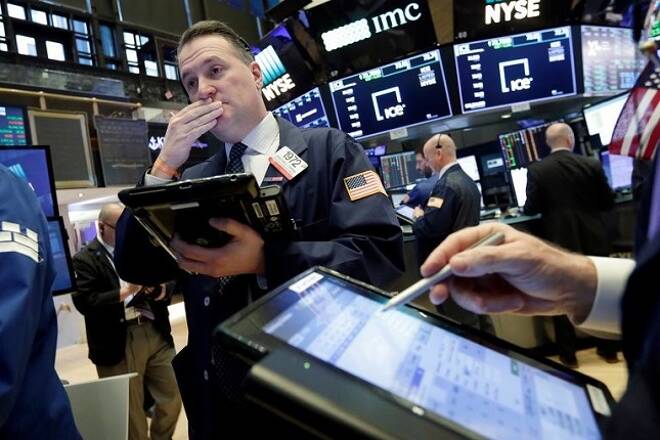Advertisement
Advertisement
A Confusing State Of Affairs
By:
Investors anxiety about the state of the global economy and apprehensions over U.S.-China trade talks pushed stocks lower Monday as political bustle swamped Washington.
Ahead of crucial trade talks the US blacklisted 8 Chinese technology firms while implicating them for human rights violations in China’s Xinjiang province. The Trump administration is walking the talk after raising human rights issues in Muslim-heavy Xinjiang at the United Nations last month and is escalating its economic war with China on yet another front.
This new shift in US strategy against China is now raising suspicions amid growing pressure stateside, that the administration may throw its support behind the pro-democracy protest in Hong Kong. All of which suggests a whole lot more than tariffs will be on the dinner menu when Chinese Vice Premier Liu He visits Washington for trade talks with his US counterparts.
Market participants are getting very jittery about all those US-China headlines -even the latest claiming China want to a partial deal while providing a timetable to work out harder issues are being met by investors with a high degree if circumspect.
A large percentage of the market thinks China may roll the dice and take advantage of what they think is President Trump weakened political state trying to push negotiation closer to the election data. In this context, President Trump may decide to hardball the upcoming talks suggesting there could be a high level of disappointment even relative to the market muted expectations.
The market continues to look unsettled, but the muted equity markets suggest investors are expecting to see very little progress from the trade talks this week. Still, if the October 15 and December 15 tariffs were to be put on hold indefinitely, it could be a significant catalyst for risk to sustain a bid at this point.
Oil market
Trade war headwinds and a dreary global macro outlook saw oil prices quickly erode early New York session gains after OPEC reported its most significant month on month output fall in 17 years. However, the report was speedily digested as a result of the attacks on Saudi Arabia’s Abqaiq processing facility, and then the dominate economic doom and gloom saga took over for the remainder of the day.
The narrative is still very much focused on the macro with the fear of economic slowdown weighing on oil demand dominating sentiment, which is now at the weakest level since February this year according to data from the US CFTE and ICE future Europe. Both exchanges reported a 17% drop in combined net bullish positions in WTI and Brent.
Against that overtly bearish backdrop, and while it’s virtually impossible to predict with any confidence how these trade talks will unfold, oil prices could be in for a sustained rally if the October 15 and December 15 tariffs were to be put on hold indefinitely which could see some of the braver at heart to support dips thinking the risk-reward skew is higher as much of the latest macro is baked into the price.
Gold markets
Gold prices fell when US treasury yields rose, and the US dollar subsequently strengthened as traders wait for the resumption of US-China trade talks. The market is going into the US-China trade talks with little expectations, so even the so-called “skinny deal” will be viewed in an extremely risk positive light. And if the next round of tariffs is put on hold indefinitely, we should expect a sustained rally on risk assets suggesting gold may lose some lustre.
The weaker global macro and the October Fed rate cut is thought to be very much in the current price, and with the October Fed cuts suggest the risk-reward may still skew to the upside. What may not be fully factored into the equation given how difficult it is to predict with any confidence, is a trade war detent which could send Gold prices tumbling as investors dive back into equities and global growth assets if such an outcome were to arise.
We continue to expect Gold traders to critique their positions against US bond yields while looking for clues from this week’s Fed speak and, some waver in the hawkish FOMC divide.
However, despite the dreary ISM data, it doesn’t appear that the more hawkish members of the FOMC are shifting their position. Kansas City President George said the recent moderation of growth was in line with her outlook but suggested she would be flexible is the data came out worse than she expected. She said she would continue to focus on the consumer while she pinned the recent strength of the dollar on the move by foreign investors to own US assets.
Boston Fed President Rosengren said the labour market remained tight and he was confident the consumer would continue to drive growth. In his view, if the economy grows at 1.7%, consumption remains strong, and inflation is gradually going up coupled with a low unemployment rate, so there is no need for further policy accommodation.
Currency markets
The dollar weakness is on hold as has been the case this year the 1.10975-1.1000 marked strong resistance on the EURUSD. It’s as if we get to that level and trader then ask themselves given how dismal the EU economy is, if we don’t buy US assets what will we buy?
But there’s a lot of watching and waiting as traders reduce some of their risk aversion bets ahead of the trade talks with the USDJPY trading above 107.25
This article was written by Stephen Innes, Asia Pacific Market Strategist at AxiTrader
About the Author
Stephen Innescontributor
With more than 25 years of experience, Stephen Innes has a deep-seated knowledge of G10 and Asian currency markets as well as precious metal and oil markets.
Advertisement
